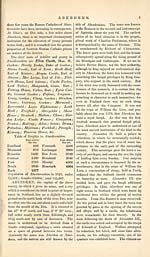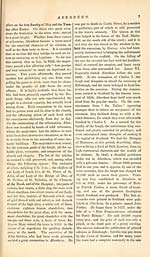Gazetteer of Scotland > Volume 1
(34) Page 6
Download files
Complete book:
Individual page:
Thumbnail gallery: Grid view | List view

ABERDEEN.
uisted Bruce in 1308, and having aided in van-
quishing the English betwixt Old Meldrum
and Inverury, they returned and put the gar-
rison to the sword. For these and other ser-
vices Robert Bruce gave some valuable pri-
vileges to the town, and donations of land
and a right of fishing. A charter which he
gave them in 1319 is the basis of the present
burgal privileges. In Edward's expedition to
the north, a band of his forces landed at Dun-
notar, and being opposed by the Aberdonians,
a battle ensued in which the latter were de-
feated, and their town sacked and burnt.
Likeas in the former case of conflagration, the
town soon recovered this calamity, and grew
in importance. At this era it carried on
a considerable trade with England, Holland,
Flanders, and Brabant. Its export was chief-
ly dried fish and salmon packed in barrels.
It traded also in corn and bacon. It is a
curious fact, that in 1299, Edward I. partly
victualled the army with which he intended to
subdue Sir "William Wallace, with fish im-
ported into England from Aberdeen. Fifty
years before this, Aberdeen was known in
Norway as a commercial port. In the four-
teenth century the dialect spoken in the town
was a singular mixture of Gaelic, Saxon, Da-
nish, British, and French, and it was not till a
subsequent epoch that the English language
assumed a complete superiority. It is pro-
bably from this circumstance that the present
disagreeable patois prevails, wherein there is a
continual substitution of the letter e for o.
The prevalence of French at the time of Ed-
ward's invasion is attested by a circumstance
connected with the motto of the city arms,
which is " Bon Accord." This was given by
Robert Bruce in commemoration of a deed
performed by the citizens in his cause, the de-
struction, to wit, of the whole English that
garrisoned their town in one night, on which
occasion Bon Accord was the watchword. At
the battle of Harlaw, eighteen miles from
the town, in 1411, the citizens are known to
have fought so bravely as to turn the fate of
the day against Donald of the Isles. The
wealth of Aberdeen at this precise period is
indicated by its being one of the four burghs,
Dundee, Aberdeen, Edinburgh, and Perth,
which became security for the ransom of King
James I. to England. From the days of the
Bruce to the times of James VI., almost
every Scottish king visited or resided for a
short time in Aberdeen. In 1448 James II.
visited it in a ceremonious manner, when he !
was presented on his entrance into the town
with a " propine," consisting of two tuns of
Gascony wine, six lights of three stones of
wax, and six pounds of sweetmeats. James
IV. repeatedly visited it, and on one occasion,
his queen, Margaret, daughter of Henry VII.,
entered it in a grand cavalcade, when she too
received a handsome " propine." In the reigns
of James I. II. and III., Aberdeen was the
seat of a royal mint at which were coined
silver groats. James V. also visited Aber-
deen. In 1530 the town was spoiled by a
great body of Forbesses under Lord Forbes,
who had been enraged on account of the ma-
gistrates refusing to give him an annual pre-
sent of a tun of wine, in requital for his pre-
servation of the fishings. His adherents were
repelled with slaughter. In 1547 the town
contributed its complement of men to repel the
invasion of the English under the Duke of
Somerset. The men took with them a piece
of cannon called the " great falcone." Nearly
all perished at Pinkey. Aberdeen, and the
shire of which it is the capital, were slow in
receiving the reformed mode of faith, a cir-
cumstance to be partly attributed to the kind-
liness of feeling which generally subsisted be-
tween the clergy and laity of the town for some
time prior to the convulsions of the Refor-
mation. The churchmen of Aberdeen were
distinguished in history for their public spirit
in carrying through local improvements, and for
public virtue in general. Few names in the
Scottish annals will match with those of
Elphinstone and Dunbar, who were suc-
cessively bishops of that see. It appears
that the clergy were great patrons of amuse-
ments, and countenanced them 'with their pre-
sence. In particular, they encouraged thaf
species of dramatic representations so well de-
scribed in the tale of " the Abbot," by the au-
thor of Waverley, under the title of the Abbot
of Unreason. They constituted two mock
priests, called the Prior and Abbot of Bon
Accord, under whose sanction all the diver-
sions went forward. In 1440 they played for
the first time the drama of Halyblude at the
Windmillhill, and then and on all similar oc-
casions the whole inhabitants turned out to
witness the spectacle, dressed in their finest
garments. The magistrates so far encouraged
these plays as to ordain that they should take
uisted Bruce in 1308, and having aided in van-
quishing the English betwixt Old Meldrum
and Inverury, they returned and put the gar-
rison to the sword. For these and other ser-
vices Robert Bruce gave some valuable pri-
vileges to the town, and donations of land
and a right of fishing. A charter which he
gave them in 1319 is the basis of the present
burgal privileges. In Edward's expedition to
the north, a band of his forces landed at Dun-
notar, and being opposed by the Aberdonians,
a battle ensued in which the latter were de-
feated, and their town sacked and burnt.
Likeas in the former case of conflagration, the
town soon recovered this calamity, and grew
in importance. At this era it carried on
a considerable trade with England, Holland,
Flanders, and Brabant. Its export was chief-
ly dried fish and salmon packed in barrels.
It traded also in corn and bacon. It is a
curious fact, that in 1299, Edward I. partly
victualled the army with which he intended to
subdue Sir "William Wallace, with fish im-
ported into England from Aberdeen. Fifty
years before this, Aberdeen was known in
Norway as a commercial port. In the four-
teenth century the dialect spoken in the town
was a singular mixture of Gaelic, Saxon, Da-
nish, British, and French, and it was not till a
subsequent epoch that the English language
assumed a complete superiority. It is pro-
bably from this circumstance that the present
disagreeable patois prevails, wherein there is a
continual substitution of the letter e for o.
The prevalence of French at the time of Ed-
ward's invasion is attested by a circumstance
connected with the motto of the city arms,
which is " Bon Accord." This was given by
Robert Bruce in commemoration of a deed
performed by the citizens in his cause, the de-
struction, to wit, of the whole English that
garrisoned their town in one night, on which
occasion Bon Accord was the watchword. At
the battle of Harlaw, eighteen miles from
the town, in 1411, the citizens are known to
have fought so bravely as to turn the fate of
the day against Donald of the Isles. The
wealth of Aberdeen at this precise period is
indicated by its being one of the four burghs,
Dundee, Aberdeen, Edinburgh, and Perth,
which became security for the ransom of King
James I. to England. From the days of the
Bruce to the times of James VI., almost
every Scottish king visited or resided for a
short time in Aberdeen. In 1448 James II.
visited it in a ceremonious manner, when he !
was presented on his entrance into the town
with a " propine," consisting of two tuns of
Gascony wine, six lights of three stones of
wax, and six pounds of sweetmeats. James
IV. repeatedly visited it, and on one occasion,
his queen, Margaret, daughter of Henry VII.,
entered it in a grand cavalcade, when she too
received a handsome " propine." In the reigns
of James I. II. and III., Aberdeen was the
seat of a royal mint at which were coined
silver groats. James V. also visited Aber-
deen. In 1530 the town was spoiled by a
great body of Forbesses under Lord Forbes,
who had been enraged on account of the ma-
gistrates refusing to give him an annual pre-
sent of a tun of wine, in requital for his pre-
servation of the fishings. His adherents were
repelled with slaughter. In 1547 the town
contributed its complement of men to repel the
invasion of the English under the Duke of
Somerset. The men took with them a piece
of cannon called the " great falcone." Nearly
all perished at Pinkey. Aberdeen, and the
shire of which it is the capital, were slow in
receiving the reformed mode of faith, a cir-
cumstance to be partly attributed to the kind-
liness of feeling which generally subsisted be-
tween the clergy and laity of the town for some
time prior to the convulsions of the Refor-
mation. The churchmen of Aberdeen were
distinguished in history for their public spirit
in carrying through local improvements, and for
public virtue in general. Few names in the
Scottish annals will match with those of
Elphinstone and Dunbar, who were suc-
cessively bishops of that see. It appears
that the clergy were great patrons of amuse-
ments, and countenanced them 'with their pre-
sence. In particular, they encouraged thaf
species of dramatic representations so well de-
scribed in the tale of " the Abbot," by the au-
thor of Waverley, under the title of the Abbot
of Unreason. They constituted two mock
priests, called the Prior and Abbot of Bon
Accord, under whose sanction all the diver-
sions went forward. In 1440 they played for
the first time the drama of Halyblude at the
Windmillhill, and then and on all similar oc-
casions the whole inhabitants turned out to
witness the spectacle, dressed in their finest
garments. The magistrates so far encouraged
these plays as to ordain that they should take
Set display mode to: Large image | Transcription
Images and transcriptions on this page, including medium image downloads, may be used under the Creative Commons Attribution 4.0 International Licence unless otherwise stated. ![]()
| Gazetteers of Scotland, 1803-1901 > Gazetteer of Scotland > Volume 1 > (34) Page 6 |
|---|
| Permanent URL | https://digital.nls.uk/97424770 |
|---|
| Description | Volume I: Abbey to Glenartney. |
|---|---|
| Attribution and copyright: |
|
| Description | By Robert Chambers and William Chambers. Glasgow: Blackie & Son, 1838. 2 volumes. |
|---|---|
| Shelfmark | NF.1461.g.7 |
| Additional NLS resources: | |

